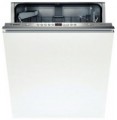Dryer type
The dishwasher has a drying function. Drying can occur both due to the natural evaporation of water from the surface of the dishes (
condensation drying), and due to its
blowing with heated air; the first option is more economical, since it does not require energy and there is also an improved one —
with a heat exchanger; the second, in turn, provides faster drying. The recently introduced new type of
Zeolith drying combines two methods, as it first collects residual moisture and then converts it into heat, which dries the dishes and belongs to premium segment models. Note that not all dishwashers are capable of drying dishes to dryness; see drying class for details.
Inverter motor
The presence of
an inverter motor in the design of the dishwasher.
Inverter motors are brushless and have higher efficiency, lower noise levels, and improved safety due to the absence of brushes. However, they are more expensive compared to conventional motors.
Energy class
The energy efficiency class characterizes the the economy of a dishwasher's electricity consumption. Initially, the classes were denoted in Latin letters from A (high degree of economy) to G (high consumption). But later, with the development of energy saving technologies, more advanced classes than A appeared. They are denoted by the letter A with a certain number of pluses (
A+,
A++, etc.); the more benefits, the higher the economy. Most modern built-in dishwashers comply with energy classes from A to
A+++(the last is 30% more economical than the original class A). More high consumption models, such as classes B and C, are much rarer and gradually disappear.
More economical models cost more, but the difference can be recouped in energy savings. Also note that the energy consumption class does not describe efficiency in general, but in comparison with other similar models; therefore, the actual consumption of a small class A device may be lower than that of a large class A++ model.
Child lock
A protective system designed for those cases when there are small children in the house. To prevent a curious child from injuring himself and ruining the dishwasher, various locks can be provided in the design — usually for the door, sometimes also for the control panel.
The child lock function turns off in a way that is easily accessible to an adult but not accessible to a child.
Dimensions (HxWxD)
Dishwasher dimensions in height, width and depth. An obvious parameter; we only note that when determining the amount of space required for integration, the width and height of the unit are important.
In most modern built-in dishwashers, the width corresponds to one of the standard values (about a centimeter):
45 cm for narrow models,
60 cm for standard ones and
55 cm as a compromise between these dimensions. As for the second dimension, dishwashers with a height of up to 60 cm inclusive are usually classified as
compact, they require installation at a certain height above the floor.
Full-size models, with a height of more than 60 cm, can also be installed at floor level.

